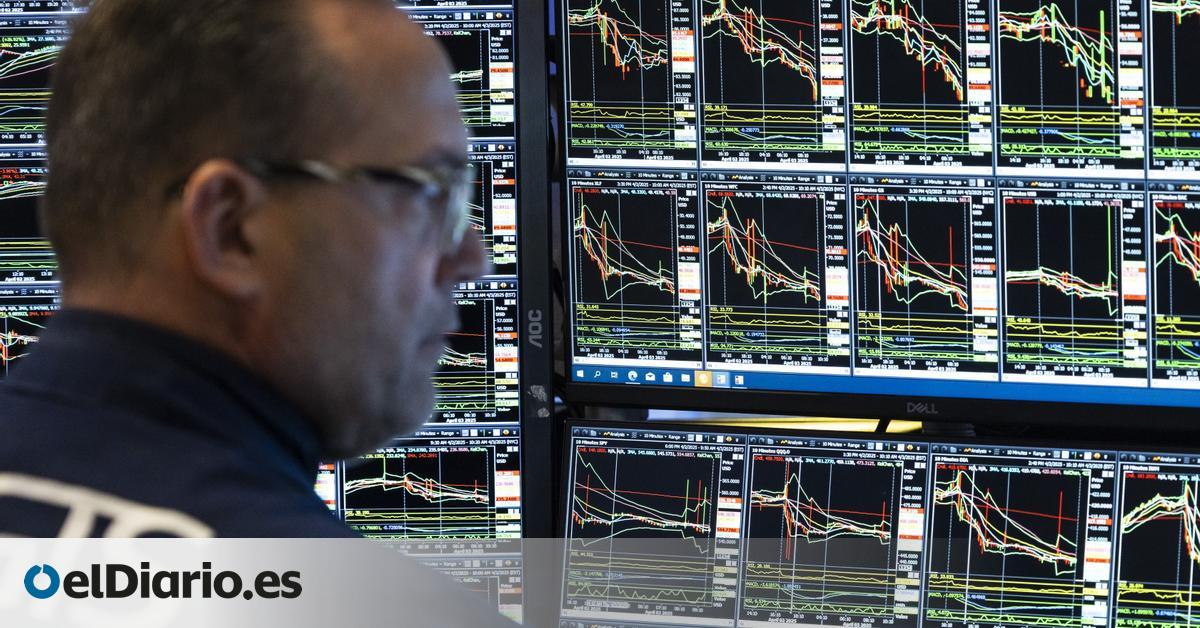
Donald Trump’s commercial war against the rest of the world arrives with several Ibex 35 companies, the main Spanish stock market indicator, more exposed than ever to the United States. Seven Spanish selective signatures (ACS, Acerinox, Arceormittal, Ferrovial, Fluidra, Grifols and Puig) have their main source of income, with a joint business figure of more than 45,000 million euros in that territory in 2024. The largest economy on the planet is also among the most relevant markets of Inditex, Iberdrola, Repsol or Santander.
Stresses the largest Spanish construction company, ACS, which last year obtained in the US 57% of its business figure: 23,737.4 million, compared to 21.2% of Australia and 8.7% of Spain, after growing there its turnover by 18.1% and its request for orders, 23.3%. It is about 60% of its total portfolio, which in 2024 beat a record with 88,209 million, 20% more.
In it, data centers stand out, with orders for about 8,000 million in the US. Its subsidiary Turner has been awarded among other projects the construction of the largest goal data center (Facebook owner), in Louisiana, of more than 10,000 million dollars. In November, he announced that he will build a data campus with an investment of 2,000 million for Vantage, giant in this sector in which a Trump intimate participates with plans to install four centers of this type in Spain.
ACS culminated in January the integration of Flatiron and Dragados North America, of its Dragados and Hochtief subsidiaries, giving rise to the second largest civil engineering and construction company in North America, with a request for orders of 18,500 million dollars, presence in 24 US states and eight Canadian provinces and income of 6,000 million. Its subsidiary Abertis provided deterioration of 1,359 million in the US for the anticipated end of the Texana Sh-288 TEXANA. It has four concessions there with 293 kilometers that last year entered 601 million.
The United States is also key to Ferrovial, whose stock market value (28.7 billion) more than doubles that of ACS, although the business figure of the construction company of Rafael del Pino (10,280 million in 2024) does not reach a quarter of the one that has the construction company of Florentino Pérez.
The Pino Construction and Services Group, one of the reference highways in North America, has its main market in the US with 27% of its business figure in 2024 (2,781 million euros), ahead of Poland (2,281 million) and Spain (2,260 million). There is 18% of its template.
After completing the controversial move of its headquarters to the Netherlands, where it has a testimonial presence, in May of last year Ferrovial began to quote in the Nasdaq index, one of its arguments for its escape from Spain, which “marked another step in our internationalization process and shows our commitment to the United States,” he says of the Pino in his last letter to the shareholders. After Friday’s stock market, on the worst day of the Ibex from the pandemic, the company has erased the profits of the exercise and left 3.1% this year.
The other signature of the selective based on Spain is the Arceormittal steel giant, with matrix in Luxembourg. Europe as a whole is its first market, with 32,773 million dollars in 2024, almost half of total sales (62,441 million). But the US is the first country for billing of the Indo -European multinational, with 8,440 million, 13.5% of the total.
There it operates through its Calvert subsidiary, a joint venture with the Japanese Nippon Steel Corp, which in October agreed to buy its 50% to try to unblock the purchase of Us Steel that the Japanese has been negotiating with the US authorities for months. Between Thursday and Friday, Arceormittal has left 15.5%in the stock market.
For the Spanish Acerinox the United States accounts for 52% of its turnover, about 2.8 billion. Having his own production there he would be safe from Trump’s protectionist measures. In 2024 he bought for $ 800 million Haynes International, leader of the high -performance alloys sector in the US, with three factories there. Acerinox plans to invest 200 million in the next four years in the United States, where it has 3,192 employees, more than in any other country (its workforce is 9,293 troops around the world, 2,626 of them in Spain).
A Spanish company with historical presence in the United States is Grifols, indicated in 2008 as an “strategic” asset by the administration of that country, according to the wikileaks cables in 2010. In 2024, the North American market contributed more than 56% of the business number of the Catalan multinational of hemoderivated, about 4.1 billion, although the sales data includes Canada. The US concentrates 64% of the entire Grifols template: more than 12,500 employees. It is the country that contributes the most to its benefit, with 346 million in 2024, followed by Ireland (314 million).
Another Catalan company of the IBEX, fluidra, also has its main market in the United States since its merger with Zodiac in 2018. North America contributes 42% of the turnover of the second world pools manufacturer, which in this market includes Canada, where it barely has 18 employees. The US was more than half of its benefit in 2024, about 100 million.
As underlines in his annual report, the new CEO, the Colombian Jaime Ramírez, former executive of Black & Decker appointed in June 2024 to replace the previous CEO, Bruce Brooks [estadounidense procedente de Zodiac]”It has been selected from candidates from that country and will also have its operational base in the United States of America. This is because of the relevance of the American market both in the current context and in the future strategy of fluidra.”
In February, before Trump’s “day of liberation” that has shaken world markets, the president of Fluidra, Eloi Plans, admitted “some exhibition” to the tariffs announced then, especially in Mexico, where Fluidra has a production component production.
Puig, also Catalan and who came out to quote at the Ibex in May 2024, also depends largely on the United States, the largest beauty market in the world and the first in net income for the group, the least punished on Friday’s black day, when it yielded 0.92%.
In 2024, North America (which also includes Mexico and Canada) contributed 1,715 million of the 4,790 million that the Puig group billed. A few days ago its executive president, Marc Puig, saw “probable” to move to the price of the product starts from Trump’s tariffs.
“Act of self -harm”
On Thursday, after Trump’s show in the White House to present what he falsely calls “reciprocal tariffs”, the French president, Emmanuel Macron, proposed to “suspend” French investments in the US. For several major Spanish companies it is already late, in a market that until nothing was given as an example of attraction of investments by several Spanish executives.
Trump has just announced the greatest protectionist barrage in a century, which Financial Times has defined as an “amazing act of self -collons”, to try to stop his galloping commercial deficit and undertake the foster taxes promised in campaign. The movement has sunk the bags around the world in two black days, will predictably drive inflation and can lead to a recession.
Without becoming its most relevant market for income, the United States is key to the largest Spanish quoted, Inditex. With factories in some of the countries most affected by the tariffs announced by Trump, such as Vietnam, the United States is the second market for billing for the owner of Zara, after Spain. In 2024 he registered there a benefit before taxes of 415 million, 5.6% more than in 2023. This figure multiplies by eight the result he obtained in 2018, the first year in which the group began to break down that data.
More important is the role that gives the United States the second largest company for capitalization of Spain, Iberdrola. For the largest Spanish electricity, it is its main expansion market for the coming years. Last year was the first destination of its gross investments (almost a third), with an increase of 29.7%. It plans to allocate there 35% of its investments in the coming years, compared to 24% of the United Kingdom and 15% of Spain. With about 10,000 megawatts installed, the US already concentrates 37% of its non -current assets (43,750 million) and a third of the asset base of its network business, more than any other market.
In February, Galán was before the analysts “sure that everything will work well” with the new Trump administration, where we have been more than 20 years “, with more than 40,000 million in assets and presence in 24 states, such as New York or Massachusetts. He affirmed that the risk for the investments planned in renewables is “minimum.” On March 11 he presented the Secretary of Energy, Chris Wright, the investment plans in networks in the US until 2030, with more than 20,000 million dollars that are added “to the 50,000 million dollars invested in the last 20 years,” said the Energy Multinational.
That bet has no equivalent reflection for now in the Iberdrola results account, which after Trump’s electoral victory erased the LGTBI content of its global website. The United States is the third country for revenue (7,751 million in 2024), after Spain (almost 17,000 million) and Brazil (9,139 million).
In the case of Repsol, it represents 9.4% of the production of the Spanish oil company and 14.6% of its reserves. But, more than for its weight in its business, it is the key to unblock its activity in Venezuela, where more than 500 million is played, after Trump’s veto threat that can materialize in a matter of weeks.
Last year Repsol launched its largest photovoltaic plant in the US. In 2021 it acquired 40% of the company of renewables Hecate Energy. Its president, Antonio Brufau, has put in recent years as an example of investment attraction. In particular to the one known as IRA, the Law on Inflation Reduction that Joe Biden launched. It has opposed the EU decarbonization policy, based on electrification and abandonment of fossil fuel production. According to Repsol, it endangers the security of the supply and makes energy more expensive.
The largest Spanish bank, Santander, also has a relevant market in the US. It is the third that contributes the most to its margin of interest (difference between the interest paid and charged), only behind Brazil and Spain: 5,693 million in 2024, and concentrates 12% of its credit risk. Santander, whose president, Ana Botín, received Trump’s praise last January at the Davos Summit (Switzerland), has an international advisory council that presides over Larry Summers, former secretary of the US Treasury.
Meanwhile, its main rival in Spain, BBVA, clothes are tempted at the effect that Trump’s tariff war will have in Mexico, which is its main market.
Source: www.eldiario.es

